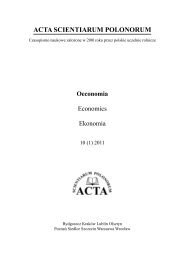INFORMATION SYSTEMS IN MANAGEMENT IV
INFORMATION SYSTEMS IN MANAGEMENT IV
INFORMATION SYSTEMS IN MANAGEMENT IV
You also want an ePaper? Increase the reach of your titles
YUMPU automatically turns print PDFs into web optimized ePapers that Google loves.
with a number of best practices that can help companies in improving the way ofdoing business.THE EVOLUTION OF ERPERP began life in the 1960s as Material Requirements Planning (MRP), an outgrowthof early efforts in bill of material processing. MRP’s inventors were lookingfor a better method of ordering material and components, and they found it inthis technique. The logic of material requirements planning is pretty simple and isbased on asking the following questions [15 p.6]:• What are we going to make?• What does it take to make it?• What do we have?• What do we have to get?This is called the universal manufacturing equation. Its logic applies to every typesof things and wherever they are being produced. Material Requirements Planningsimulates the universal manufacturing equation. It uses the master schedule (Whatare we going to make?), the bill of material (What does it take to make it?), andinventory records (What do we have?) to determine future requirements (What dowe have to get?). The main objectives of MRP system are:• To ensure that materials and products are available for production and deliveryto customers,• To maintain the lowest possible level of inventory,• To plan manufacturing activities, delivery schedules and purchasing activities.MRP systems are not common nowadays as they have a lot of limitations. Thoselimitations describes H. Klaus in one of his lectures:“MRP were the first off-the-shelf business application to support the creation andmaintenance of material master data and bill-of-materials (demand-based planning)across all products and ports in one or more plants. These early packages were ableto process mass data but only with limited processing depth”[8 p.141].Visual depiction of this and the subsequent evolutionary steps presentsFigure 4. MRP quickly evolved, however, into something more than merely a betterway to order. Early users soon found that Material Requirements Planning containedcapabilities far greater than merely giving better signals for reordering. Theylearned this technique could help to keep order due dates valid after the orders hadbeen released to production or to suppliers. MRP could detect when the due date ofan order (when it’s scheduled to arrive) was out of phase with its need date (whenit’s required). This was a breakthrough. For the first time ever in manufacturing,there was a formal mechanism for keeping priorities valid in a constantly changingenvironment. The function of keeping order due dates valid and synchronized withthese changes is known as priority planning.39
















